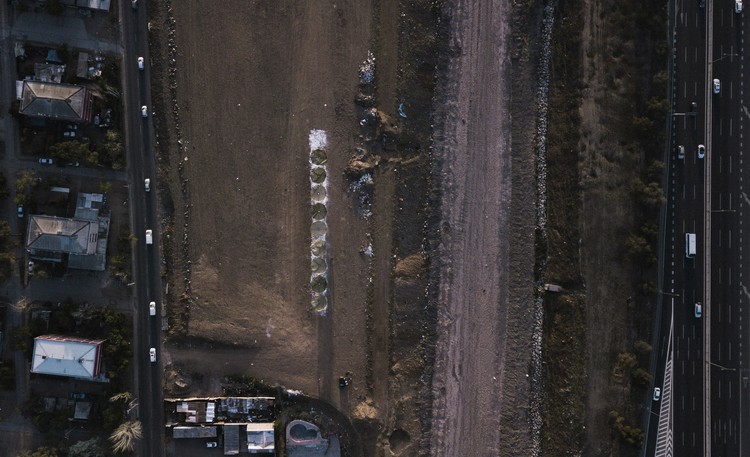Human Rights Day is celebrated every year on the 10th of December. After visiting numerous sites that commemorate the scenes of regrettable crimes against humanity and violence, one common observation can be made: the place of memory is not only a building. In fact, it is more about the encounter, the appropriation, and the gesture.
With this idea in mind, Chilean architect Miguel Uribe Rubilar designed the temporary memorial “Absent Body”. He explains:
Temporary Memorial “Absent Body” (Memorial Temporal Cuerpo Ausente) is a wake-up call project situated on a political execution site during the military dictatorship of Chile (1973–1990), on the banks of the Mapocho River, Santiago, used at some point as an unplanned burial ground.
According to witnesses and official documents, trucks arrived with political prisoners who would be forced to run towards the river, in order to execute them for attempting to escape. These unfortunate events marked deeply the location that was not properly appraised. Currently, a project is being built that does not consider the weight of urban memory but contributes to the valorization of the potential memory site.
In June 2019 the construction of that project was stopped due to legal problems. Given the inactivity status of the land, the construction of a temporary memorial was proposed: an architectural work with the intention of creating temporary appropriation as well as giving meaning and value to the memory of the victims and the public space, the scene of graves and executions.

Temporary Memorial “Absent Body” proposes 10 parachutes, written off by the Chilean army, as the main material of this commemorative event, with the intention of reinterpreting their function. Hanging and inverting these textiles eliminates their past use. The usage of wind as a natural component generates form variations, creating complete new spatial experiences. Positioned as an east-west line of 10 parachutes, the intervention is located perpendicularly to the route walked by those that were executed, as a sign of opposition and symbolic demand. In addition, being parallel to the Mapocho River recognizes in a way this geographical piece of memory. The length of 62 meters commemorates the original distance from the riverbank that the victims had to travel. Each parachute was hung from a network of steel cables, supported by a removable structure of tubular steel profiles. On another hand, the ground floor of the project was demarcated with a mixture of plaster and lime leaving a white mark on the land and used to expand the area.


This project had the support and collaboration of a neighborhood organization called Ribera Sur, which made it possible to present the project for funding, from the grants of the Municipality of Cerro Navia. In fact, it was awarded the maximum amount that can be allocated for large initiatives, allowing its construction.

The academic degree logic encourages students to demonstrate their acquired skills, abilities, and knowledge in order to develop creative and innovative solutions at a professional level. In this final process, university internal laws were used to build this architecture, generating a real impact on a specific community. Temporary Memorial “Absent Body” is listed as the first work built in a University (UNAB), which never had a degree project materialized before.
Project: Memorial Temporal Cuerpo Ausente (Memorial Temporal Cuerpo Ausente)
Architect: Miguel Uribe Rubilar
Professor Guide: Gregorio Brugnoli Errazuriz
Site: Ribera Rio Mapocho, Cerro Navia, Santiago, Chile
Commission: Degree Thesis, Escuela de Arquitectura de la Universidad Andrés Bello.
Team: Jonathan Ormazábal, Julio Droguett, Héctor Rivera, Sandra Rubilar, Hernán Uribe, Sebastián Miranda, Pablo García, Fernando Jara, Nicolás Moncada, Dariel Méndez, Ramón Cortes, Diego Bermejo, Miguel Uribe Rubilar.
Materials: Chilean Army parachute ø 6.2 m, Removable structure of tubular Steel 1 ”e: 2mm and 1” 1/4 e: 2mm; modulation according to ø Parachute; 1/8 steel cable, 10mm fluted iron stakes, Substrate covered with plaster and lime.
Financing: Municipality of Cerro Navia, Neighborhood Ideas Funds 2019.
Collaborating media: Ribera Sur Neighborhood Organization, Museum of Memory and Human Rights, London 38, Villa Grimaldi Corporation, Creative Campus.
Built surface: 385 m2
Land area: 38.598 m2
Year of Project: 2018-2019
Year of Construction: 2019
Photography: Pablo Casals Aguirre




